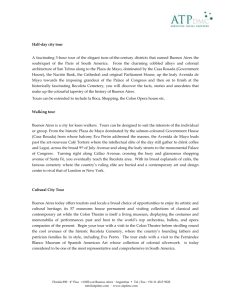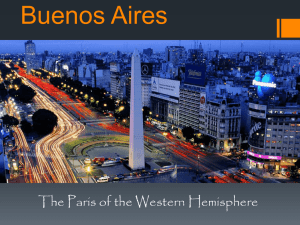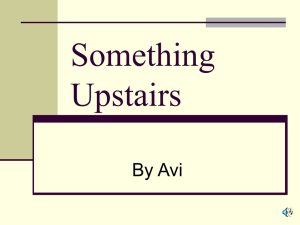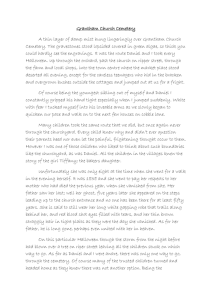BUENOS AIRES – MAY 2013 ENG 294 – Capital of Culture
advertisement
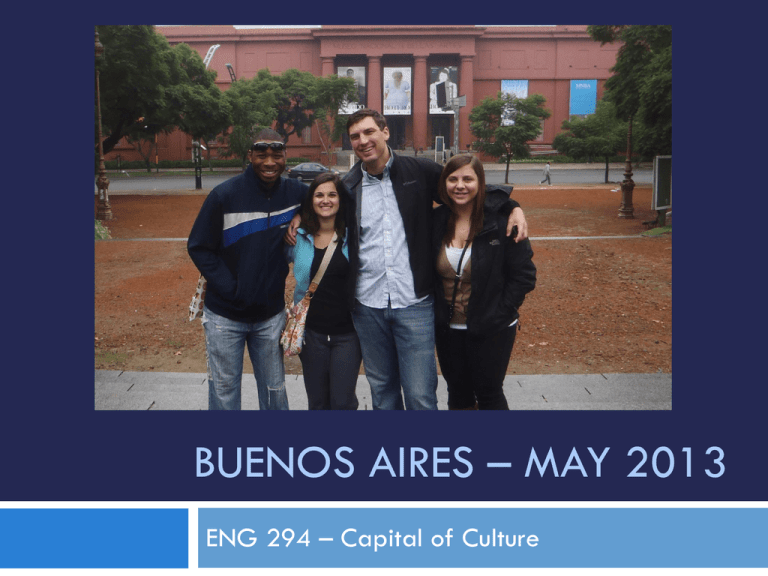
BUENOS AIRES – MAY 2013 ENG 294 – Capital of Culture Day 1 – Arrival and Coffee Friday, May 17 We arrive in the morning and walk to the obelisk (r), then go for coffee and media lunas at Café Tortoni – always rated one of the 10 Most Beautiful Cafes in the World – and also manage to find the park where the characters in The Tunnel would often meet. On Cover (l-r) – Kenny Gilliard, Ashleigh Huffman, Daniel Faulkenberry and Juliane Bullard stand in Plaza Francia with the National Museum of Fine Arts behind them. This was a short walk from the hotel and just across the street from the flea market. EL ATENEO GRAN SPLENDID Day 2 – Exploring the City of Books Saturday, May 18 Day 2 – La Biela and El Ateneo This coffee shop across the green from Recoleta Cemetery is one of the most famous in the city, frequented by celebrities, past and present. Previous page: (l-r) Ashleigh Huffman, Kenny Gilliard, Daniel Faulkenberry and Juliane Bullard walk across the bridge over Avenida Libertador, linking the Recoleta Cemetery area to the law school and the park holding the steel flower, Floralis Generica, which supposedly opens at dawn and closes at dusk – although no one’s actually seen it in action. La Biela – The “Tie Rod” This is a great spot for breakfast or just hanging out for a coffee. You can even sit and have your picture taken with authors Jorge Luis Borges and Bioy Casares. Note the cutout on the chair – it’s a tie rod, a reference to the café’s early days. On to the bookstore (l-r) Daniel Faulkenberry, Ashleigh Huffman, Juliane Bullard and Kenny Gilliard stand at the balcony level of El Ateneo. Note the sweep of books to the left and the stage’s curtain to the right. It started as an opera house. More of El Ateneo Daniel Faulkenberry checks out the books. What other bookstore has gilding and chandeliers like these? Sunday, May 19 Day 3 – Flea Market and Fine Art (l-r) Daniel Faulkenberry, Kenny Gilliard, Juliane Bullard and Ashleigh Huffman stand in front of one of the many monuments in this city. This one is in Plaza Francia just across the street from the National Museum of Fine Arts. This is also just down the street from the Recoleta Flea Market. Recoleta Flea Market Kenny Gilliard takes a break from shopping in the hundreds of stalls on the green outside of the cemetery to snack on a beef sandwich, an Argentine specialty. Breakfast and Fine Arts Breakfast at Il Doge near the flea market. Note the design on the café latte; details are celebrated in Argentina. The fine arts museum had a wonderful exhibit on Botero. Left is a painting of gauchos by Della Valle. Day 4 – Touring the City Monday, May 20 Kenny Gilliard, l, and Daniel Faulkenberry stand in front of Floralis Genérica, the huge stainless steel sculpture outside of the law school that supposedly opens and close at dusk and dawn. Left, Kenny dances tango in La Boca. La Boca The bus tour allows for plenty of time at La Boca, the original port and most colorful part of the city. This is where a huge influx of Italians, mostly from Genoa, settled around the turn of the century. Why are the buildings such crazy colors? When the ships docked and had leftover paint, the Italians took whatever was in the cans and painted their homes with it. The Colors of La Boca Above, a coffee shop that is also known for its amazing chocolate and alfajores. Right, La Perla, another coffee shop dedicated to tango and singers. Take a look inside; have a coffee. The woman in the closeup is Tita Merello, a singer as famous for her voice as for her homely face. La Boca - Caminito Left, Juliane, Kenny and Ashleigh sit on the steps of one of the most photogenic – and colorful – corners of Caminito. Below, a coffee shop displays a dozen ways they can make you a coffee. La Boca – A Salute to its Origins Celebrating its brothel heritage, many of the buildings have mannequins of men and women of low repute populating the balconies. Left, a typical streetlight set against a colorful building. In the heyday of tango, young men would make a date to meet the pretty women they had just met at the milonga dance underneath these lights. And they would keep on waiting for the women who generally never came. They were known as esquinazos, literally, “corner men.” Tuesday, May 21 Day 5 – Xul Solar Lunch at Tandoor, just across the street from the Xul Solar Museum Xul Solar Solar worked mainly in watercolors with fantasy subjects, but he also designed this museum. Predictably, the style is his own and evokes Escher’s concepts of warped staircases and walls that begin and end spontaneously. Solar used a wealth of numerology and astrological references and named each painting in a language he himself made up. Solar’s “Pan” World Right, the main hall of the museum. Below, the game of “Pan Chess” that Solar invented in which rules were constantly being reinvented. Also in the museum is a piano he invented. It has colored keys, and he invented a musical notation to go along with the visual concept that was linked to his paintings. Day 6 - MALBA Wednesday, May 22 The Latin American Art Museum of Buenos Aires always presents the most challenging and avant-garde works. When we visited, the guest artist was a Brazilian exploring aspects of cannibalism. More interesting than it sounds. Right, this chair trails off like wood spaghetti, drapes over the walls and hangs over the ground floor. The Art of MALBA Kenny, l, contemplates a portrait of Che Guevara while Daniel looks through a “bubble” sculpture. Recoleta Cemetery Welcome to the place where 6,000 stories are told of the history of Buenos Aires – and the nation itself. (l-r) Daniel, Juliane, Ashleigh and Kenny stand in front of the monument to Pedro Eugenio Aramburu, a former president whose body was kidnapped right from this grave. It’s now well sealed with concrete. Evita Above, an overview of the cemetery from the church’s second floor. (r) Ashleigh and Juliane pause in front of the Duarte family tomb, Evita’s burial place. Firpo A life-size statue of Luis Ángel Firpo stands in front of his tomb. He fought Jack Dempsey in 1923 in what sportswriters still regard as the greatest boxing match of all time. See how you measure up. Lilana Juliane and Ashleigh pet the nose of Liliana Crociati de Szaszak’s beloved dog, Sabú. His bronze nose is shiny from all the rubbing visitors give it. Usually, one of the cemetery cats is lying in the grass, and they love to be petted, too. Liliana was 26 when she died in an avalanche in Austria. Avenues The cemetery has “avenues” just like any other city, and here Kenny and Daniel lean against a tomb (r) that took on the shape of a boat, one of the interests of the man buried here. Below, Daniel with one of the many cemetery cats. Wandering The cemetery is laid out on a grid, so don’t be afraid to wander around. Eventually, you’ll come to a wall. Follow it, and you’ll find the exit. Day 7 - The National Library This library is equivalent to our Library of Congress, and is an amazing place to do research. Ask the tour guide about its style of architecture that features unfinished concrete. Thursday, May 23 Exhibition of Carlos Trillo This political cartoonist had an extensive exhibit. He was fearless when it came to commenting on the dictatorships of the period. Trillo’s Work The exhibit included many of his strips and even a model of his work space. Day 8 – The Tango Lesson A night of dance lessons at La Viruta in the bohemian part of town. Tango, salsa, swing and more tango – dance till dawn and meet other college students! Friday, May 24 Saturday, May 25 Day 9 – Hugo Gambini Prize-winning journalist and author of the definitive biography of revolutionary Che Guevara, Hugo Gambini and his translator/wife Alicia, have lunch with the students and discuss his writing and Buenos Aires, the city that formed Guevara. Guevara – A Life Daniel and Kenny ask author Hugo Gambini about his life and work, especially working in past decades when the political atmosphere in Buenos Aires was volatile and violent. A Gift Author Hugo Gambini presents a copy of his bestselling book to Daniel and Juliane. Sunday, May 26 Day 10 – San Telmo Flea Market Almost a mile of stalls along Defensa that end at Plaza Dorrego. Plaza Dorrego This is a view from Miei Amici, an Italian restaurant on the second floor that overlooks Plaza Dorrego. This is Defensa. Puppeteers, musicians and living statues are everywhere. Vendors Line the Street Whatever you can think of, someone is probably selling it at a stall somewhere. For some reason, a lot of stalls sell siphons. Need a Sign? Above, this ornate style of hand-painted sign is typical of Buenos Aires and originates with the Genovese that settled in the area. Around the Plaza Left, the emblem of the San Telmo area. Left, more handpainted signs. Lower left, glassware and silver are plentiful in stalls. From the Balcony Another view of Defensa and Plaza Dorrego from Miei Amici. These covered stalls pack the entire plaza. Monday, May 27 Finally – Steak Dinner! The students chose Melo, the restaurant next to the hotel, for their big evening out. Steak for Everyone Above, Kenny and Ashleigh order. (r) Kenny digs into a plate of calamari. We Dig In! Above, Argentina is known for having the best steak in the world, and this cozy restaurant proved that right. (r) To finish, we ordered this massive dessert of ice cream, fruit and nuts – and five spoons! Tuesday, May 28 Day 13 - The Tunnel Presentations Our last real day, we end as we began – at the most beautiful café in the world. Tortoni’s History Café Tortoni was the center of art, literature and music for decades. Above, the central dining area. Note the stained glass skylight. Above, life-size figures of Borges, Gardel and Storni still sit here, just as they did decades ago. Left, Carlos Gardel. Presenting Right, Juliane and Ashleigh and (below) Kenny read from their journals. We are in a back room that used to be a billiard room. More Tortoni The walls of the café are filled with the paintings and sketches of the artists who used to spend their time here. Upper right, Daniel reads his work. Right, Luigi Pirandello. Winding Up An afternoon of eating and scholarship draws to a close. Wednesday, May 29 ¡Adios! Buenos Aires Juliane, Ashleigh, Dan and Kenny stand in front of the obelisk in the heart of Buenos Aires. They are on the sidewalk beside the Nueve de Julio, the widest street in the world. Next stop: Home!
